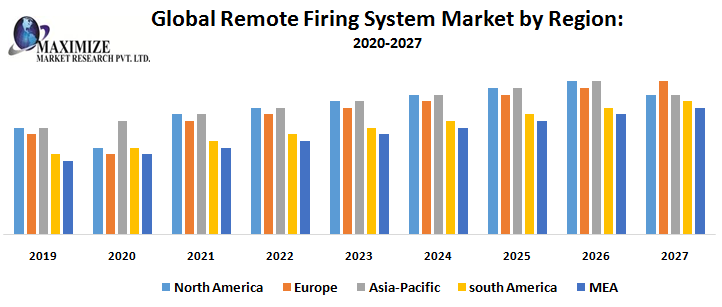Remote Firing System Market Projected to Reach USD 830.11 Billion by 2027 as Fire Control and Tactical Integration Accelerate
Market Size
- Estimated Value (2023): USD 1.05 Billion
- Forecasted Value (2030): USD 1.8 Billion
- Compound Annual Growth Rate (CAGR): Approximately 8.0% (2024–2030)
Overview
While maintaining humans at a safe distance, remote shooting systems allow the safe, precise, and frequently automated deployment of munitions, such as artillery and rockets. These technologies, which provide network-centric warfare capabilities, automated targeting, and integration with fire-control systems, are essential parts of changing military architectures. Rapid adoption is being driven by the expansion of defense modernization programs, border security, and unmanned platforms.
To Know More About This Report Request A Free Sample Copy https://www.maximizemarketresearch.com/request-sample/32801/
Market Estimation & Definition
The market encompasses hardware and software solutions for remote-controlled firing of munitions. These systems may be vehicle-mounted, tripod-based, or incorporated into fixed fortifications, supporting both lethal and non-lethal payloads. The market value is expected to grow from around USD 1.05 billion in 2023 to USD 1.8 billion by 2030.
Market Growth Drivers & Opportunities
- Modernization of Defense Forces: Military upgrades worldwide are investing in safer, more efficient remote weaponry systems.
- Unmanned Platforms Expansion: Integration into UAVs, ground robots, and autonomous systems enhances operational flexibility.
- Network-Centric Warfare: Remote firing systems are integrated into tactical networks for faster targeting and coordinated strikes.
- Border and Internal Security: Remote deployment of tear gas, crowd control munitions, and surveillance payloads is increasing in use-case scenarios.
- Precision Munitions Use: Demand for accurate, controlled firing to minimize collateral damage supports market expansion.
Segmentation Analysis
By Platform Type:
- Vehicle-Mounted Systems
- Man-Portable / Tripod Systems
- Fixed-Site Installations
By Payload Type:
- Artillery Rockets
- Grenades & Shells
- Non-Lethal Weapons
- Anti-UAV Munitions
By Range:
- Short Range (<5 km)
- Medium Range (5–15 km)
- Long Range (>15 km)
By End-User:
- Military Forces
- Law Enforcement / Border Control
- Homeland Security
- Strategic Installations (e.g., airports, ports)
By Region:
- North America
- Europe
- Asia-Pacific
- Middle East & Africa
- Latin America
Major Manufacturers
Key industry players include:
- Lockheed Martin
- Raytheon Technologies
- BAE Systems
- Northrop Grumman
- Thales Group
- Saab AB
- Rafael Advanced Defense Systems
- Leonardo S.p.A.
- General Dynamics
- Elbit Systems
- Nexter
- Rosoboronexport
- Hanwha Defense
- Denel
- QinetiQ
Regional Analysis
North America:
Leads with advanced platforms, strong defense budgets, and high integration of autonomous firing systems.
Europe:
Active modernization across NATO countries; emphasis on unmanned integration and border defense technologies.
Asia-Pacific:
Rapidly growing region with major investments in modernization from India, China, South Korea, and ASEAN countries.
Middle East & Africa:
Increasing defense and internal security demands driving adoption amid regional tensions.
Latin America:
Emerging interest in border security and modernization projects within mid- to long-range profiles.
COVID‑19 Impact Analysis
The pandemic disrupted supply chains and delayed defense exercises in 2020. Subsequently, delayed modernization projects resumed and accelerated, with governments pushing strategic capability upgrades and manufacturer deliveries to resume by mid-2021.
Commutator Analysis
Remote firing systems rely on electronic control units and signal routing—not mechanical commutation. Critical system features include:
- Secure Communications: Encrypted RF or fiber connections for command and control.
- Precision Timing: Synchronization protocols for integrated targeting systems.
- Redundancy and Fail-Safe Design: Ensures safe operation under combat or emergency conditions.
- Modular Architecture: Rapid payload and range adaptability.
- Autonomy Features: From semi-automated firing to fully autonomous targeting within defined rules of engagement.
Key Questions Answered
- What is the market projection by 2030?
USD 1.8 Billion. - What is the estimated CAGR?
About 8.0%. - Which platform type is most prevalent?
Vehicle-mounted systems dominate the market. - Who are the key end-users?
Military forces and law enforcement agencies. - Which region leads in adoption?
North America, followed by Europe and Asia-Pacific. - How did COVID-19 impact production?
Initial delays followed by accelerated procurement and delivery. - What are emerging trends?
Integration into unmanned platforms, increased autonomy, secure networking, and portable non-lethal weapon applications.
Conclusion
The global remote firing system market is set for robust growth, with adoption expected to rise from USD 1.05 billion in 2023 to USD 1.8 billion by 2030. Driven by defense modernization, unmanned platform deployment, and enhanced security needs, remote weapon systems are becoming standard in tactical environments. Providers who offer secure, versatile, and modular solutions aligned with evolving combat and security doctrines will lead the market
About Maximize Market Research
Maximize Market Research Pvt. Ltd. is a global market research and consulting company headquartered in Pune, India. The firm specializes in data-driven insights across industries such as automotive, healthcare, electronics, and technology. Its team provides custom reports and strategic recommendations to support business growth and market entry.
Contact Us
Maximize Market Research Pvt. Ltd.
2nd Floor, Navale IT Park, Phase 3
Pune-Bangalore Highway, Narhe
Pune, Maharashtra 411041, India
📞 +91 96073 65656
✉️ sales@maximizemarketresearch.com


